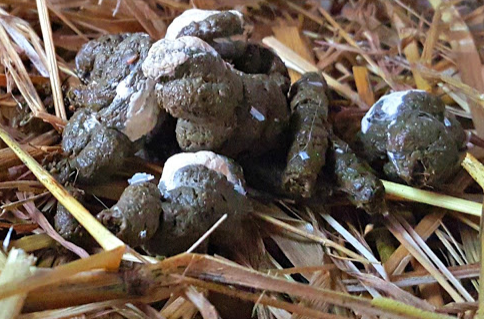

Part of proper chicken care includes being able to spot when something is wrong. This can mean being observant on several levels, from watching your chickens’ eating habits to monitoring their behavior. Another indicator of health problems in chicken is the state of their feces. Being able to tell the difference between what is normal and what is not can aid in the detection of illness, as abnormal droppings is often a sign that disease or illness could be present and needs to be addressed.
There are a lot of illnesses and diseases that can befall our chickens. Learning all of the details about each and every one is a daunting, if not impossible, prospect. What is more realistic is learning the signs of those illnesses and diseases so that the red flag can be raised and diagnosis can begin. From there it just so happens that chicken droppings is an easy place to start your analysis. Basically, there are three normal types of chicken droppings. If you learn these three types, you will be able to recognize problem poop and know when further assessment of your chickens is needed.
1. The most common and completely normal variety of chicken droppings is brown or greenish in color with a white spot on top. Since chickens do not urinate like other animals, the white spot on top of the faeces is the product of their urinary system. This spot, which is made up of urate, combines with the rest of the waste being passed through the intestines upon reaching the cloaca and is passed out of the bird as a complete unit.
2. Broody hens who nest continuously throughout the day will also have another type of dropping. Since they do not want to relieve themselves in the nest where chicks will hatch, broody hens essentially hold it for long periods of time. This usually amounts to relieving themselves only about twice per day. As a result, the faeces of a broody hen will be much larger than normal (3 or 4 times as large even) and will have a much more pungent odor than usual.
3. The last normal type of chicken poop is that which originates in the ceca. The ceca is a branch of intestine that absorbs water from faeces to aid in fermentation of food that was not previously broken down enough. This area also must be emptied a few times daily and results in poop with a very strong odor as well as a different color and texture. It is often gooey in consistency and ranges in color from black to yellow, with the darker colors being more offending to your sense of smell.
While there will be some variation in colors amongst normal dropping due to what your chicken is eating, it should fit the bill for what is normal in form and consistency overall. Occasionally you may notice bits of red in chicken faeces which can also be normal as pieces of intestinal wall sometimes break loose and pass along with faeces; seeing a lot of red is a sign of trouble, however. Taking note of where each chicken rests at night will help you identify the problem as chickens tend to rest in the same location. Since abnormal poop can be a sign of health issues, it is important to be able to narrow down the responsible party so treatment can be administered, although some issues will require treatment of the whole flock.
Reasons droppings might be abnormal include but are not limited to:Bacterial Infections, Cancer, Coccidisosis, Worms
In some cases, abnormal poop may be an isolated incident. When you notice something amiss, be sure to check for additional signs of illness, such as lethargy, weight loss, decreased production, and disinterest in food or water. Be sure to back up any of your assumptions with confirmation of illness and a plan of treatment from a qualified vet. With a little luck, your chicken will be plagued only by minor problems and will be good as new again soon. However, if your chicken is facing a fatal illness, it is important to know this as well so suffering will not be prolonged. When it comes to discerning between potential problems, be sure to check that poop.
 Contact Jaguza Support
Contact Jaguza Support